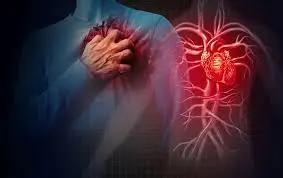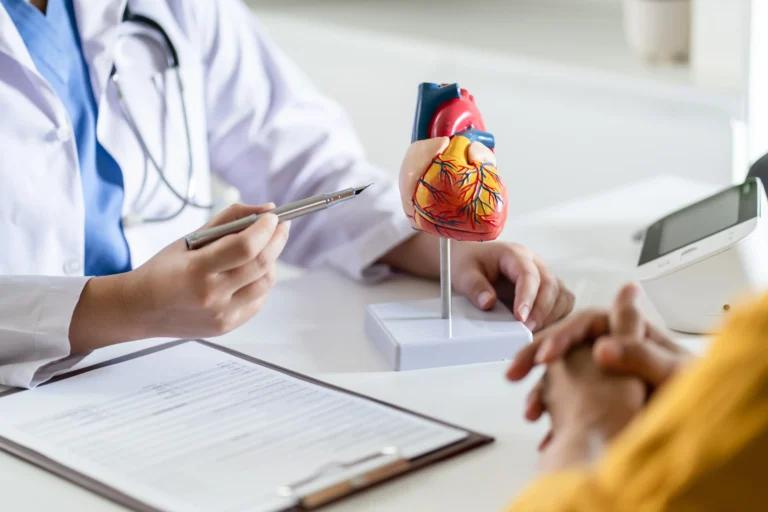Chances are you’ve heard of angina before, but maybe you’re not quite sure what it is. Angina is more often the presenting symptom of coronary artery disease and is caused by reduced blood flow to the heart. Angina typically feels like a squeezing sensation or pain in the chest. It can also feel like indigestion.
Angina is a common condition and affects millions of people worldwide. It’s important to see your doctor if you think you might be experiencing angina because, while it’s not usually life-threatening, it can be a sign of a more serious condition like a heart attack. In this blog post, we’ll explore everything you need to know about angina, from symptoms to treatment options.
What is Angina?
Angina also called Angina pectoris occurs when the arteries that supply blood to the heart muscle become narrowed or blocked. This can happen for a number of reasons, including plaque buildup, diabetes, high blood pressure and smoking. When these arteries become narrowed or blocked, it reduces the amount of blood and oxygen that gets to the heart muscle.
What are the causes of Angina?
Coronary artery disease (CAD) is the most common cause of angina, which is the buildup of plaque in your arteries. Plaque is made up of fat, cholesterol, calcium and other substances found in the blood. When plaque builds up, it hardens and narrows the arteries, making it difficult for blood to flow through. This is called atherosclerosis. This can cause angina because the reduced blood flow means that the heart isn’t getting enough oxygen.
Angina can also be caused by other heart conditions that affect heart function, such as heart failure or cardiomyopathy.
What are the different types of angina?
There are different types of angina, each with its own symptoms and treatment options. The most common type of angina is stable angina, which is often brought on by physical activity or emotional stress. The symptoms of stable angina can include chest pain, tightness or discomfort that goes away with rest or medication.
Another type of angina is unstable angina, which is more severe and can happen without any trigger. The symptoms of unstable angina are similar to those of stable angina, but they may be more intense and last longer. Unstable angina can be a sign of a heart attack, so it’s important to seek medical attention right away.
Microvascular angina (MVA) is a type of angina that happens when the small arteries in your heart are damaged. This can reduce blood flow to your heart muscle, and you may feel chest pain. MVA is different from the more common type of angina, which happens when one of the large coronary arteries is blocked. The symptoms of MVA are often similar to those of coronary artery disease (CAD), but they can be harder to diagnose because the damage is in small arteries instead of larger ones.
Finally, there is variant angina, which is also called Prinzmetal’s angina or coronary artery spasm. A coronary artery spasm is chest tightness or pain caused by the tightening of a heart artery. This type of angina is caused by a spasm of the muscle layer in the wall of the blood vessels which leads to a temporary artery blockage. The symptoms of variant angina can include chest pain that happens at rest and is relieved by nitroglycerin medication. If you think you may be experiencing any type of angina, it’s important to see your doctor for an evaluation.
Symptoms of Angina
The most common symptom of angina is chest pain or discomfort that feels like squeezing, crushing or pressure in your chest. Angina pain may also spread to your shoulders, arms, jaw, neck, or back. Other symptoms may include shortness of breath, nausea, vomiting, lightheadedness or fatigue. If you experience any of these symptoms, it’s important to seek medical attention right away because it may be indicative of a heart attack.
Angina is not a heart attack, but it’s a warning sign that one could happen. If you have angina, your risk of a heart attack goes up. That’s why it’s important to see your doctor if you develop any new or worsening symptoms of angina. Angina usually gets better with rest and medicine. But if it gets worse or happens more often, it may be a sign of an impending heart attack. If you have heart attack symptoms, call the emergency services immediately. Early treatment can save lives.
How is Angina diagnosed?
The first step in diagnosing angina is usually a physical exam and a review of your medical history. Your doctor will ask about any symptoms you’re experiencing and how often they occur. Your doctor will also ask about risk factors for CAD, such as high blood pressure, diabetes, smoking and a family history of early heart disease.
After the physical exam, your doctor may order tests to check for CAD. These tests can show how narrow your coronary arteries have become and how well your heart is functioning. Common tests used to diagnose CAD include:
- Blood tests. These tests check for high levels of certain enzymes that are released into your blood when your heart is damaged or not getting enough oxygen
- An electrocardiogram (ECG or EKG). This test records electrical activity in your heart through sensors placed on your skin. An ECG shows how fast your heart is beating and whether its rhythm is steady or irregular. It can also show evidence of a previous heart attack or damage to your heart from CAD
- Stress tests. These tests help find out how well blood flows to your heart during physical activity. Physical activity makes your heart work harder and pump more blood so that more oxygen-rich blood flows to the muscles. During this test, you exercise on a treadmill or stationary bike while hooked up to an ECG machine. A nuclear stress test uses special imaging along with an ECG during exercise to evaluate blood flow through the arteries leading to your heart muscle
- Imaging tests such as coronary angiography (CA). A dye is injected into an artery in your arm or leg. X-rays are then taken to see if any arteries are blocked or narrowed. The resulting images are known as coronary angiograms. This test is also called cardiac catheterisation or cardiac cath lab (cath lab) study
- Computed tomography angiography (CTA), magnetic resonance angiography (MRA), echocardiography (echo), and cardiac magnetic resonance imaging (MRI). These tests create images of the arteries that supply blood to your heart so that doctors can look for blockages
- Coronary calcium scan: A type of low-dose CT scan that looks for deposits of calcium in the coronary arteries
What are the risk factors for angina?
There are several risk factors that can increase your risk of coronary heart disease and angina.
They include:
- Stress
- Sedentary lifestyle
- Smoking
- Diabetes
- Obesity
- High cholesterol
- High blood pressure
- Family history of heart disease or heart problems
- Age (45+ for men and 55+ for women)
Treatment for Angina
The goal of treatment for angina is to improve blood flow to the heart and relieve symptoms. There are different treatments for angina, depending on the underlying cause. The three types of treatments are lifestyle changes, medication and surgery.
Lifestyle changes
If you have angina, healthy lifestyle changes can help improve your symptoms and heart health. One change you can make is to quit smoking. Smoking narrows your blood vessels, which reduces blood flow to your heart and can worsen angina. If you don’t smoke, don’t start. If you do smoke, quitting is the best way to improve your angina.
Another change is eating a healthy diet containing a variety of nutrient-rich foods, including fruits, vegetables, whole grains, low-fat dairy, lean protein sources and healthy fats. Eating a healthy diet can help you maintain a healthy weight, control blood pressure and cholesterol levels, and improve blood sugar control.
Increased physical activity can also help improve angina. Physical activity helps to pump more blood through your heart and body, which can help reduce the symptoms of angina. Exercise also helps to improve cholesterol and blood pressure levels. To get started, aim for at least 30 minutes of moderate-intensity aerobic activity on most days of the week. If you haven’t been active for a while, start slow and gradually increase your level of activity.
These changes may not seem like much, but they can make a big difference in how well your heart functions and how much pain you feel. Talk to your doctor about what lifestyle changes are right for you. Making even small changes can help improve your angina and your overall health.
Medication
Medications can be used to improve angina symptoms by widening the arteries and increasing blood flow to the heart. There are several different types of medications available for the treatment depending on many factors including; severity of symptoms, reaction to other medications or medical conditions. Some common medications used to treat angina include:
Prevent an angina attack
- Beta-blockers (to slow the heart rate and reduce oxygen demand) e.g. propranolol and atenolol
- Nitrates (to dilate arteries and improve blood flow) e.g. isosorbide mononitrate and glyceryl trinitrate
- Calcium channel blockers e.g. diltiazem and verapamil
Prevent progression
- Aspirin to prevent clotting
- Statins lower your cholesterol levels and stabilise fatty deposits in the coronary arteries
These medications can be used alone or in combination depending on what works best for you with your physician’s care. In some cases where medication does provide significant relief, other treatments such as surgery may also be necessary and discussed with your physician team.
Surgery
In some cases, surgery may also be necessary to open narrowed arteries and improve blood flow to the heart. Surgery may be an option if you have severe CAD or if other treatments haven’t worked. Angioplasty, coronary artery bypass surgery, and stenting are all surgical options that can improve angina.
Angioplasty is a procedure where a small balloon is inflated in the blocked artery to open it up. This procedure is often combined with the placement of a stent, which is a small wire mesh tube that helps to keep the artery open.
Coronary artery bypass surgery is a more invasive option that involves taking a healthy blood vessel from another part of your body and attaching it to the blocked coronary artery. This bypass surgery can help to improve blood flow and relieve symptoms of angina.
How is angina different from a heart attack?
Angina is a symptom of an underlying condition while a heart attack is a medical emergency. Both angina and heart attack occurs when there is not enough blood flow to your heart muscle but the cause of the reduced blood flow is different.
With angina, the flow of blood is restricted due to the narrowing of the coronary arteries, while in a heart attack, the blood supply is blocked completely by a blood clot. Both heart and angina attacks can cause chest pain and shortness of breath, but a heart attack is usually more severe. Heart attacks also have a higher risk of complications, such as cardiac arrest, cardiac tissue damage and even death. If you think you may be experiencing a heart attack, it is important to seek medical attention immediately.
If you think you might be experiencing angina, it’s important to see your healthcare provider because it could be a sign of a more serious condition like a heart attack. The good news is that there are treatment options available for angina depending on its severity and underlying cause. With lifestyle changes, medication or surgery, many people are able to manage their symptoms and live relatively normal lives despite having this condition. If you think you might have angina, talk to your doctor today about treatment options that are right for you.
Sources
Medical Disclaimer
NowPatient has taken all reasonable steps to ensure that all material is factually accurate, complete, and current. However, the knowledge and experience of a qualified healthcare professional should always be sought after instead of using the information on this page. Before taking any drug, you should always speak to your doctor or another qualified healthcare provider.
The information provided here about medications is subject to change and is not meant to include all uses, precautions, warnings, directions, drug interactions, allergic reactions, or negative effects. The absence of warnings or other information for a particular medication does not imply that the medication or medication combination is appropriate for all patients or for all possible purposes.








